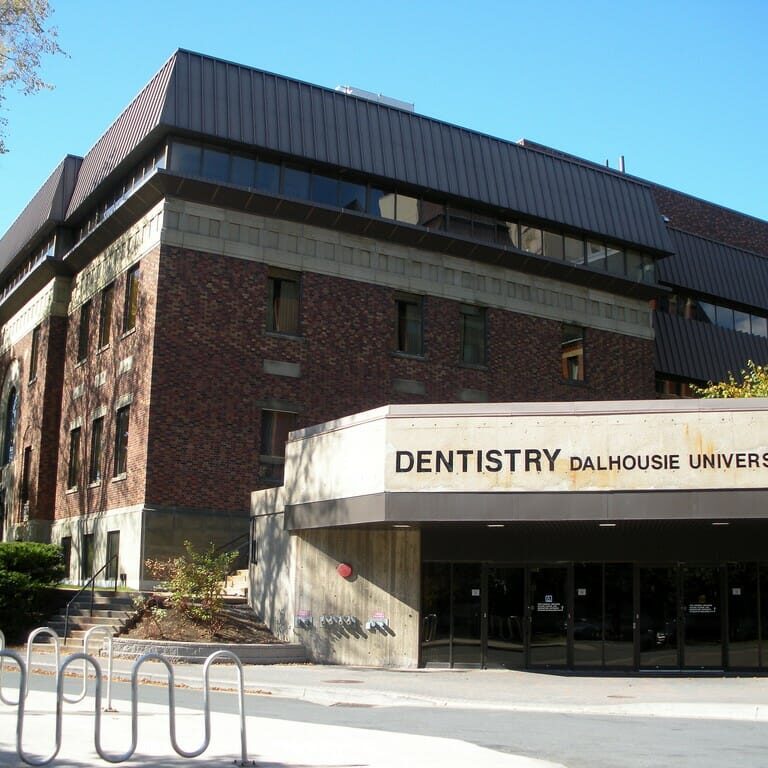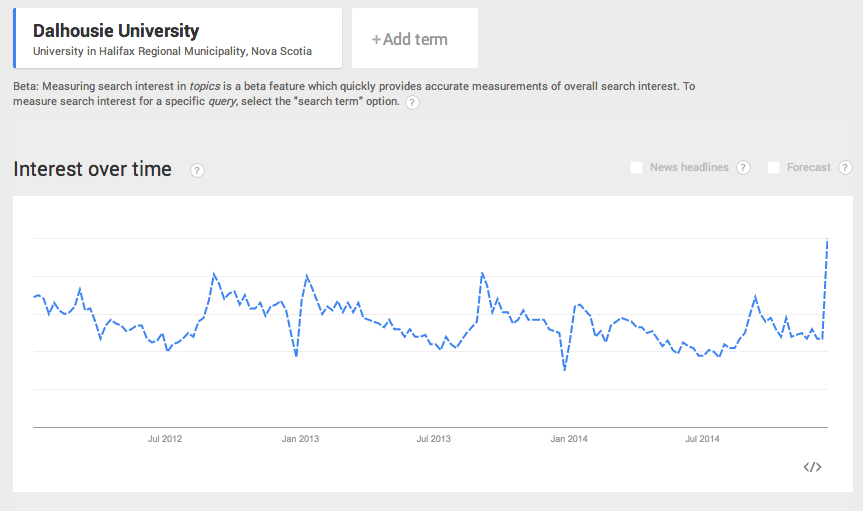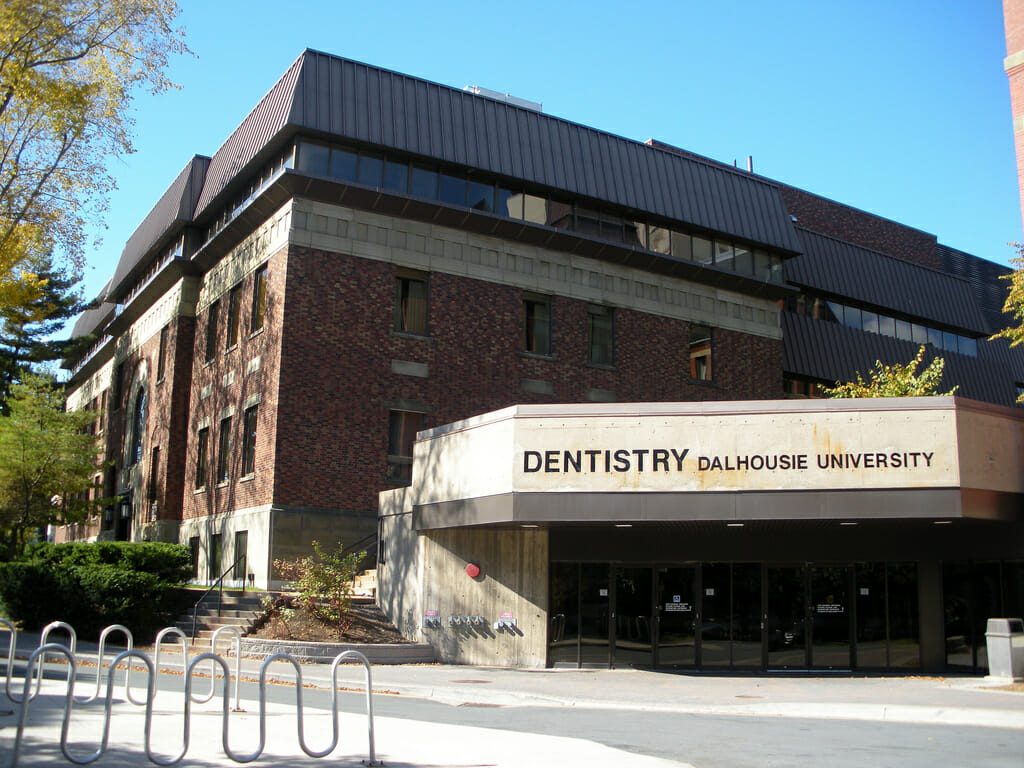
Questions in dentistry scandal go unanswered amid extensive media coverage
Contradictions and inaccuracy surround communication around misogynist Gentlemen group
In the final days of 2014, Dalhousie University is being searched for on Google more now than during any period within the last two years.
The news is national and constant – 13 male fourth-year students in Dalhousie’s school of dentistry were members of a Facebook group where some of them posted misogynistic, sexually violent material, some of it directly aimed at their female classmates.
All of the people searching Google to read about the scandal at Dalhousie will come across dozens of media reports. They’ll find video coverage of Friday’s rally to expel the men, analysis of the #dalhousiehateswomen Twitter hashtag that has attracted thousands of posts, and commentary from a myriad of experts who have weighed in on their ideal means of handling the case.
But the media reports they come across will not contain answers to some of the most important questions we seriously deserve to know the answer to, and these reports sometimes contain inaccuracies.
Many important questions have not yet been answered:
- Did the university administration make any effort to consult all or any of the women targeted in posts by the group?
- Did the university administration make any effort to consult all or any of the women in the fourth-year dentistry class who may not have been directly targeted in posts by the group?
- We’re told the approach was “victim-centred” – if this is the case, why were women only given the two options within Dal’s Sexual Harassment Policy? Were they ever given the option of having Dal administration have the men tried against the school’s Code of Conduct? Why has the answer to that question not been communicated to the public?
- Why is Dalhousie giving asymmetric information about the number of men and women in the case, then citing legal reasons?
- If a dentistry professor was forced to email an apology to his students for showing a video of women in bikinis to “wake up” the men in the class this year, and Florizone is saying he was only made aware of this incident this week, why is he only hearing of it now? Is that not the kind of information that makes it his way?
- How did Dalhousie determine that just two women were “most affected” by the posts in the group, and how did these two women happen to also be the only women who came forward opting for restorative justice?
- Dalhousie has announced they want a “victim-centred” approach, but some of the grossly misogynistic posts do not target specific women. What should the punishment be for these, or are posts in a private Facebook group void from being tried under Dal’s Code of Conduct unless they mention specific people?
- What is president Florizone’s response to people concerned and upset by his editorial in the Chronicle Herald where he says students who do not feel safe “will not have to go back to classes”?
- What is being done to protect the future of the men in the 2015 dentistry class who weren’t ever associated with the group, if there are any? Does Dalhousie not consider these innocent men victims even though their professional reputations are at stake?
- Why has the Dalhousie Dentistry Student Society been silent through this?
A close look at the publically-available information on the case of the Class of DDS 2015 Gentlemen page shows a mass of contradictions, confusion and miscommunication.
The news breaks and Florizone gives his first response, but how much do we know?
Since the first media report published on Monday, the general public has not had an accurate idea of what the group looked like.
On Monday, the CBC told us they had “obtained screenshots of the group’s posts” and some of the posts in the group “appear to involve discussions of female classmates.” We were told at least a dozen men were in the group, and they were posting in the group since 2011, until they recently closed it.
We knew some of these men voted in a poll one of them made titled “Who would you hate fuck”, same for a poll on “sport fucking” – two jokes about using chloroform to incapacitate women appear, and having sex with a woman until she’s unconscious is recommended as a form of “stress relief”.
We knew that some of the men showed no remorse or foresight when they believed their group was compromised:
“RED ALERT!!!!! RED F–KING ALERT!!!!!” reads one post. “Apparently one of the ladies has seen or heard something about the recent posts in the gentleman’s. We have to get rid of the evidence.”
The group then launched another poll asking its members whether it should “Do nothing,” “Hold off unless the shit hits the fan,” “Put posts on the DDS Class of 2015,” or “Issue statement of some sort.”
But at 0:58 in the video in the CBC’s first report, reporter Tom Murphy says, “Among the posts, a poll, asking in very graphic and vulgar terms, to vote on which of two female classmates they would like to have sex with,” while the “hate fuck” poll is shown.
The written report does not explicitly say the two options in the poll were women in the class – just that the group “appeared to involve discussions of female classmates” – but the video report says so directly. Were they confident the poll was about women in the class? If so, why wouldn’t they make that clear in the written story?
It’s horrible either way, but it makes a difference. Dalhousie’s response to the group was largely based around the fact that women students in the dentistry program were indeed directly targeted.
Florizone gave his first public response to the group later that night: “On behalf of Dalhousie University, I want to express my deep disappointment and concern with reports of offensive comments shared in a social media group about female students in Dalhousie’s Faculty of Dentistry.”
His emphasis is on the comments about female students, a foreshadowing of Dalhousie administration’s choice to not pursue trying the men in the group under the code of student conduct but to leave possible punishments up to some women who were targeted by the group.
It was also announced the remaining fourth-year dentistry exams would be delayed until January, to prevent student anxiety.
In the Chronicle Herald’s initial reporting on the case, the final two paragraphs of the story refer to a social media scandal at Saint Mary’s University that occurred in January:
“[…] another scandal broke when several SMU football players were found to be using social media to broadcast messages of hate, racism and sexism.
The university suspended 10 members of the Huskies football team.”
Those players were never suspended from the university, though – they were just suspended from the football team, and this was after the season had finished.
Just saying “the university suspended” them makes it seem like there is a precedent for university students in Halifax to be suspended over misogynistic social media posts, but this hasn’t happened yet.
How many is “many women”? Two?
In a CTV video released on Tuesday, a reporter says of the group’s content, “postings are alleged to be sexual in nature and portray violence towards women, including two specific female students in 4th-year.”
Florizone is shown, saying, “So those women, who were referred to in those posts, that’s been my primary concern – their needs, understanding how they’ve been impacted by this.”
This was the first and only time a number was given by the media for how many female dentistry students were directly mentioned, or who may have directly appeared in pictures, in the group. But CTV never explained how they determined that number, and they stopped using the figure of “two” the next day.
In CTV’s story, the reporter says suspensions are a possibility for the men in the group, and Florizone is shown saying that suspensions are a possibility under Dal’s harassment policy.
This seems contrary to the text of Dal’s Sexual Harassment Policy, which eventually became the guiding disciplinary document of the case – the policy only allows for informal resolution procedures or formal complaints.
Both of these processes may result in suspension, but they can both also possibly result in no discipline taken, or even expulsion. Why was CTV specifically focused on the possibility of suspensions, when so many other possibilities were just as likely at this point?
The CBC also announced on this day that they had been sent 45 pages of screenshots from someone who had access to the group before it was eventually closed, giving more transparency to what they knew. We still don’t know how much may have been published on the group that was never screen-captured and delivered to the media or Dalhousie administration.
The CBC published an editorial explaining why they were not (yet) publishing the names of the 13 men, and also an interview with Jennifer Nowoselski, Vice President (Internal) of the Dalhousie Student Union (DSU), who said Florizone had known of complaints of sexism within the faculty of dentistry since the summer.
Nowoselski said the DSU was approached in the summer by dentistry students who had complaints about “sexual harassment and sexist comments and preferential treatment of male students, especially in clinical settings.”
They brought the complaints forward to Florizone, with the permission of the complainants. Florizone directed the complaints to the university’s Human Rights, Equity and Harassment Prevention, who then could not guarantee anonymity for the complainants. Florizone confirmed with the CBC that he made this referral.
Because anonymity could not be guaranteed and the women did not want to be further discriminated against for filing a complaint, they did not proceed further.
On Wednesday, Florizone would give a press conference on the university’s discipline decision in the case of the DDS Gentlemen group. But he did not mention the complaints that came forward in the summer, and no members of the media brought it up.
It was also on Tuesday that the Globe and Mail published that 26 men and 21 women were in the class of 2015.
While it’s not the sort of detail that normally gets cited in a news story, these statistics on the class’ gender ratio are not attributed in the story.
But assuming those figures are correct, at this point, we only knew “at least a dozen” of these 26 men were in the group. The next day, we would learn it was 13 men.
Swimsuit video complaints reached dean, but not the president
Further news broke of sexism within the faculty of dentistry on Wednesday when the CBC published an interview with a female dentistry student, who declined to be named, told a story of being subject to sexist behaviour during class earlier this year.
She said a male dentistry professor had screened a video of Sports Illustrated swimsuit models during an 8 a.m. class to “wake up” the men in the class.
After feeling what happened was inappropriate, she says, she and many of the women in the class sent emails to the dean’s office saying they were not ok with this sort of behaviour from faculty.
Shortly after the complaints, she says, the professor emailed apologies to everyone in the class.
On a Thursday CTV interview, Steve Murphy asked Florizone if it was possible that the bikini video screening could have possibly happened. Florizone said he had been made aware of this report in the last day.
If the dean of dentistry had known about the swimsuit video airing earlier in the year, and that many women students were upset with this happening, why would Florizone never have been made aware of this? Shouldn’t the president of a university know when a number of students in a professional classroom are complaining about sexist behaviour from a professor?
If it’s the case that no one made Florizone aware of the swimsuit video and its ensuing complaints when it happened – if the dean had done so, would Florizone possibly have been spurred to investigate further into what was going on in the faculty of dentistry, being reminded of the complaints he heard in the summer?
Tom Boran, dean of the faculty of dentistry, has not appeared in the media during this scandal.
…and restorative justice for “many”?
By Wednesday, CTV was reporting that “Some fourth-year female dentistry students are named in some of the posts,” dropping their earlier figure of two.
Shortly after 6 p.m., Dalhousie released another report by Florizone.
Florizone announces in the report that “many of the women who were the subject of the comments” in the group had come forward to the university, without giving a real number.
These women did so under the university’s Sexual Harassment Policy, which offers two options: an informal resolution procedure and a formal complaint procedure.
With the announcement the women chose a process offered by the informal resolution procedure, it was the first time out of dozens we would hear the words “restorative justice” in the upcoming days. Florizone emphasized his commitment to a “victim-centred approach”.
We know that Dalhousie administration did not choose to decide their own disciplinary action for these men, but that they say they presented two options to “many” women who came forward about the posts.
Here is where it’s worth remembering that some female dentistry students elected to not pursue anything this summer when they were told their complaints would not be anonymous.
But as far as we know in this case – which is very little – no women came forward to the administration to complain and then rejected pursuing options of the sexual harassment policy specifically because they could not remain anonymous.
It should definitely be considered that some women would not want to come forward at all because they know they could not be anonymous, or they do not want to complain for any number of valid reasons.
By putting the onus on these women to come forward, the university is saying action will only occur if these women come forward, and then if they agree to void their anonymity while they pursue either of their options under the sexual harassment policy.
We don’t know if any women have been offered the following victim-centred proposition: “If you want, instead of you having to operate through the Sexual Harassment Policy, we can pursue academic discipline for you under the Student Code of Conduct through the Senate’s disciplinary committee.”
One 4th-year female dentistry student told the CBC on Thursday why she thinks restorative justice is unacceptable for this case.
“It feels shocking to be asked to discipline my own peers. That’s not my job. It’s good that they’re asking for our input but … we don’t know all the facts. How can we be asked to make a decision based on partial information about our peers? It’s very, very hard,” she said.
It is also unclear whether the university made any efforts to contact women who appeared in the group’s posts. While it’s possible they may have, Dalhousie administration has made no indication they reached out to these victims, or how many victims there were total.
In a Thursday CTV interview with Steve Murphy, Florizone did not deny that he had the power to pursue disciplinary action through options other than the Sexual Harassment Policy – disciplinary action that could have ultimately entailed suspension or expulsion of the 13 men.
“What I would have had to do is to take a different process than the women elected to, and we could take a different process to seek expulsion,” said Florizone. “What I want to do is follow the process they’ve outlined, and that may lead to different considerations or different processes.”
The fact that none of Dal’s internal complaint processes for sexual harassment like this would allow for women who would potentially complain to remain anonymous – that the only option the university gave affected women is to have the men who rated who among them they’d rather “hate fuck” know that they’re now complaining, when the university already knew that women in the summer backed down from Dal’s internal complaints processes when they knew they couldn’t remain anonymous – was not addressed in this interview.

Protesters gathered in a silent march towards Dalhousie’s administrative building on Friday during a rally to expel the members of the DDS Gentlemen group. (Photo by Eleanor Davidson)
And the “victim-centred” approach Florizone has repeatedly emphasized also means the men are ostensibly only facing action from the university for their messages that directly targeted their women classmates, while we know some of the really awful posts didn’t target specific individuals.
Here’s a thought: if Monday’s revelation had been that these men in dentistry had instead been posting polls about “hate fucking” celebrities, for example, their messages would still be sexually violent but not with any of their female classmates targeted.
Is there no way they then could still be tried under Dal’s code of conduct for openly talking about imagined scenarios of raping women and administering incapacitating drugs to women who aren’t on campus?
It would appear something is seriously wrong at Dalhousie if we would allow some of our professional students to openly talk for years about raping people, when these professional students will soon graduate and have access to the nitrous oxide they’re currently joking about, as long as the people they’re talking about aren’t members of the Dalhousie community.
But if that would be a punishable offence under the student code of conduct, why hasn’t the university administration explained why trying the men under the code of conduct is or isn’t an option for some of their posts that do not target specific women?
When the CBC published a post from the group where a man defines a penis as “the tool used to wean and convert lesbians and virgins into useful, productive members of society” and another man responded, “And by productive I’m assuming you mean it inspires them to become chefs, housekeepers, babysitters, etc.” – this is seriously homophobic, misogynistic content, but it doesn’t target any individual women.
Does Dalhousie not consider that a violation of conduct for medical professionals? Are these the standards of character we’re willing to accept for the dentists currently practicing in Dalhousie’s dental clinic, often on members of the most vulnerable communities?
By Tuesday, Florizone still hadn’t reviewed all the screenshots of the group that were available, according to the Globe and Mail. It is unclear if the university administration has seen them all by now.
But by focusing on their victim-centred approach, Dalhousie administration has not communicated whether they believe there should be academic discipline or could be academic discipline for the misogynistic and homophobic posts that do not target individuals.
In his CTV interview with Steve Murphy, Florizone said that the men’s posts are not less serious offences than academic offences that have seen students been suspended and expelled.
The most recent report of Dalhousie Senate’s disciplinary committee says expulsion has been the penalty for five cases of an academic offence at Dalhousie since the 2005-2006 academic year.
If the posts that don’t specifically target any women can be considered to be worse than plagiarism, then why couldn’t they be taken to the disciplinary committee as violations of Dal’s student code of conduct?
And if there are men in the class who have never been associated with the group, how are they not considered victims? The confidentiality of the restorative justice that the two women have opted for means the names of the 13 men who were in the group will be kept a secret by Dalhousie. It seems that the men’s names could only come out if they elect to come forward with them, if the CBC or the Globe and Mail or any other media outlet that may have the uncensored screenshots chooses to publish the names, or if their names are leaked somehow.
If the restorative justice process results in no discipline for the 13 group members and they all graduate without being named, being a man with a Dalhousie Dentistry diploma from 2015 now means many people will not trust your services – no matter whether you were one of the men who joked about rape, you’ve lost a lot of potential clients. The success of the men who were never associated with the group will be seriously impacted. What victim-centred approach will be taken for them?
Does a victim-centred approach neglect to include all victims?
It’s not clear that the victim-centred approach means the university administration went out of their way to reach out to any of the women targeted in the group.
Less than an hour after the restorative justice decision was announced, Florizone held a press conference in the Henry Hicks Building. During the question period, Frances Willick of the Chronicle Herald asked Florizone how many women have come forward to the university with complaints.
Florizone had to refer this question to a member of Dal’s legal counsel on site. The counsel said that because of the amount of information that’s publically available about the case in the media, it could be possible to identify the individuals, and that would violate the confidentiality and privacy of the restorative justice process.
“Unfortunately, I can’t talk about the numbers,” said Florizone.
Later in the conference, after a reporter asked about whether he had met with any of the men in the group, Florizone said, “I have not met with them directly. In 48 hours, my concern has been most on the women students, and I’ve met with two of them.”
If you watch the entire 41-minute CBC broadcast of the president’s conference, he never says only two women came forward. At one point, he does say “many of the women who were the subject of the comments, as well as members of the Facebook group, have come forward,” and “many” would only be accurate if – let’s say, more than two women affected – had come forward.
He also said he corresponded with some of the men in the group, but had not yet directly met with any of them.
It’s entirely possible that more than two women came forward, but he only personally met with two of them. It’s also possible Florizone’s definition of “many” could include “two” in certain cases.
So, “many” women came forward, and that number could be as little as two, but we don’t know the number for sure.
Discrepancies in confidentiality
While he was advised to not quote the number of women who came forward, the legal counsel had no problem approving Florizone’s announcements that there were 13 men in the Facebook group, that they’re all 4th-year students, and that there are 47 students in the class of 2015.
(Dal’s academic timetable, a dynamically-updated list of courses available at Dal and how many students are enrolled in them, confirms all fourth-year dentistry classes currently with students have 47 students enrolled. The exception is two fourth-year classes that only have 46 students.)
In a televised Thursday interview with Steve Murphy on CTV News, Florizone said he would be breaking the law to give the names of the 13 men.
The answer couldn’t be that the complaining women’s identities must be kept private from the men, because the only processes the university has offered any women potentially affected would not guarantee their anonymity.
At his Wednesday press conference, Florizone said:
“… but I think we’ve tried to be guided by these principles we laid out 48 hours ago. In particular, I have found that in choosing these options amidst the many voices, listening to the voices of those students most directly affected, those women … and meeting with them personally today, because this route, when I say I’m taking a victim-centred approach, that implies that I’m providing assurance to this community that we are following the wishes of these women.”
Saying he met with the women “who were most directly affected”, but also that he only met two women, implies Dalhousie administration believes two women were most directly affected by the group. We have no idea how the university may have determined these two women were “most directly affected” as opposed to other women who appeared in pictures or postings in the group, or who didn’t appear in postings but are still expected to return to classes in January with classmates who have joked for years about raping the other women in the class.
Hey, we know at least four different women were directly targeted in the group: this screenshot that was released by the CBC shows a man in the group joking about a man beating off onto classmates, as a caption to a cropped picture of one man behind four women wearing dental lab coats.
Yet we don’t know how it was determined at least two of the women in this picture were not “most affected” by the group.
At least one woman has anonymously come forward saying she was targeted in the group, but she was not consulted by Dalhousie about restorative justice.
And Florizone mentioned at his Wednesday press conference that more women may come forward looking for a resolution through the sexual harassment policy. He also mentioned in an interview Thursday with CTV’s Steve Murphy that one woman who was affected came forward and said she did not want to proceed with a restorative justice process.
“Now, we do know through the media and through women I’ve spoken with, there may be others who have other complaints,” said Florizone.
He said he did receive a letter from a woman who says she does not want restorative justice, but wants to go a “different route.” There was no elaboration on this, and there have been no updates on her case.
Could it be that only a small number of women – maybe as little as two – came forward to Dalhousie, and the university administration made no effort to reach out either to other women who they knew were directly targeted by the group as well as other women who were in the class but weren’t directly targeted, but they just don’t want to say that?
If this is the case, it seems like their “victim-centred” approach has avoided reaching out to at least a few victims.
If it isn’t the case, this suspicion could be dismissed by Dalhousie administration giving the public more facts about what’s happening.
Until then, people will only assume the worst: that no women in the class were reached out to by Dal administration and Dal administration did not independently seek discipline for these men – they just want everything to blow over with no process of justice sought.
What is next?
I’m wondering why the Dalhousie Dental Students Society, that represents every Dalhousie Dentistry student, has not said a thing about this. They have had no social media presence this year, just a website that occasionally has pictures of events uploaded to it. Do they have nothing to say about what happened?
And what will Florizone say next to address the questions and concerns being brought forward? In an opinion piece first published Thursday night by the Chronicle Herald, he’s quoted as saying:
“Let me very clear: no student in the faculty of dentistry will have to go back to classes if they do not feel safe, and no staff member, faculty member or patient in the faculty will be put in a situation where they do not feel safe.”
A lot of frustration has come out against this paragraph on social media, and justly so. Women who have had rape jokes made towards them by their classmates should never have to avoid classes because they do not feel safe, but it sounds like he’s saying this could happen.
What bizarre precedent would this set? It would say that men who enroll in this program in the future don’t need to worry about joking for years about raping their classmates, because if their classmates feel unsafe, they can just skip class.
Dalhousie administration did not provide us with any updates on Saturday. Today is Sunday, and it’s four days until Christmas, but the public is still largely frustrated and they’re not forgetting this quickly – the online petition to expel the 13 men has over 10,387 signatures, and new signatures are still coming in every few minutes.
There are prominent alumni who have said they may cut their associations with Dalhousie.
And you still have students who have made strong statements against the administration – over an hour after Florizone’s vague restorative justice announcement, the Dalhousie Student Union made bold demands of Dalhousie in a statement they released. To remark on the significance of this fully will require another editorial. But here is one of their demands:
“The Dalhousie Student Union is calling on the university to commit to examining and addressing the root causes that allow cultures of misogyny and sexism to continue to exist at our university, especially in areas of study that have traditionally been male-dominated.”
It’s true that many areas of study at Dalhousie have been traditionally male-dominated. And for proof that cultures of misogyny and sexism exist at Dal, just look at the DDS Gentlemen group. But here’s another part of Dal that’s traditionally been male-dominated: the DSU executive body.
According to Dal’s data for enrolment by gender (which only recognizes male and female as possible genders, and that’s a problem, but it’s the only data we have), there were 10,175 women and 8,265 men enrolled at Dalhousie as of Dec. 1, 2013.
This means women are 55.1 per cent of the membership of the DSU. This year, two women appear on the five-person executive body, but the two previous years saw all-male executives.
If the DSU would wish to address the traditional gender diversity issues in their own executive body, wouldn’t they want to advertise their paid staff positions and council committee positions to as many people as possible, of all backgrounds and gender expressions?
Experience at these levels makes students responsible for the union’s success and prepares them for taking on larger roles. The DSU could lead here by advertising their open positions intensely to reach as diverse an audience as possible.
But the Gazette has reported time and time again this year on how the DSU routinely fails to engage students in their activities, how they almost never advertise their paid jobs and never advertise their non-council member positions on committees.
The problems plaguing the DSU this year are largely problems of communication, both internal and external. And we know it’s partially problems of communication that have led to a huge swath of outrage against Dalhousie administration this week.
A lot of that frustration has come out attached to the #dalhousiehateswomen hashtag. And even on that hashtag, you will find dispute over whether people using the hashtag truly believe Dalhousie administration hates women or if these words are meant to be symbolic.
Well, here’s a hashtag everyone can feel comfortable with: #dalhousielackscommunication
Update, Dec. 21, 2014, 1:45 p.m. AST: This story originally said Florizone said he met with the two women who were most directly affected during an interview with CTV News. He actually said this at a press conference on Wednesday. The story has been updated to reflect this.
Update, Dec. 28, 2014, 10:40 p.m. AST: This story original called CBC reporter Tom Murphy “Jim Murphy”. This error has been corrected.











